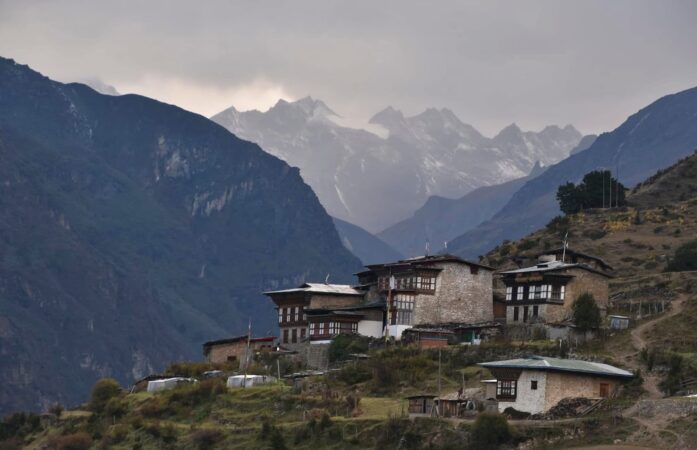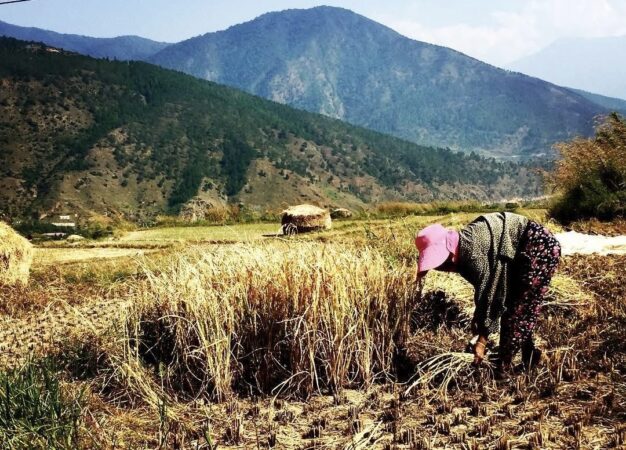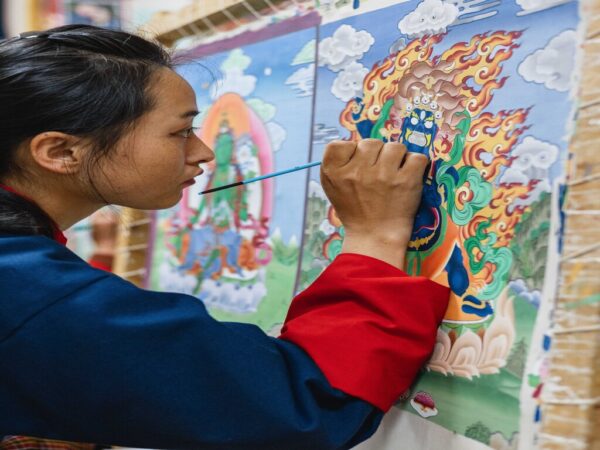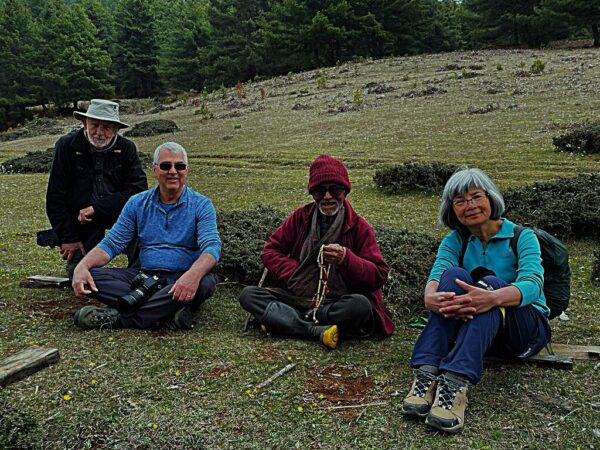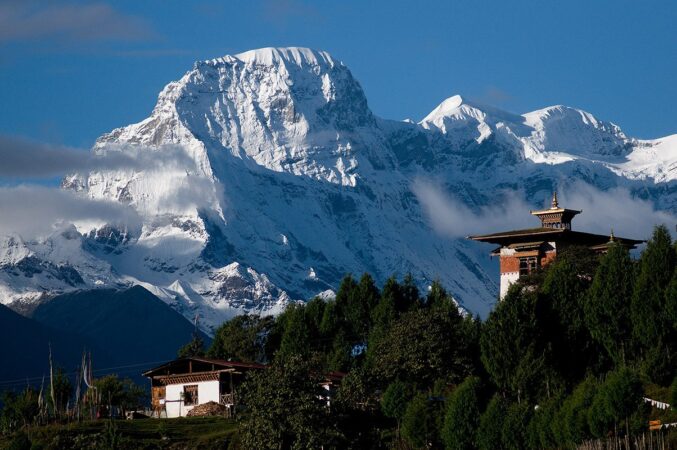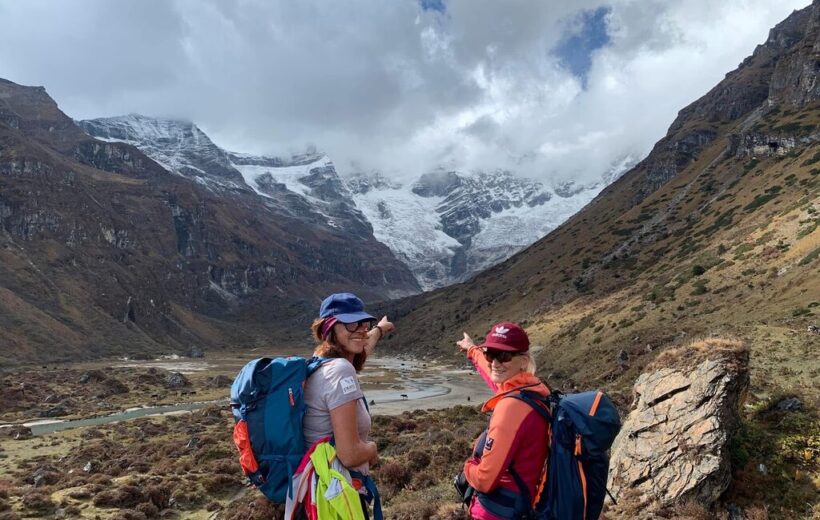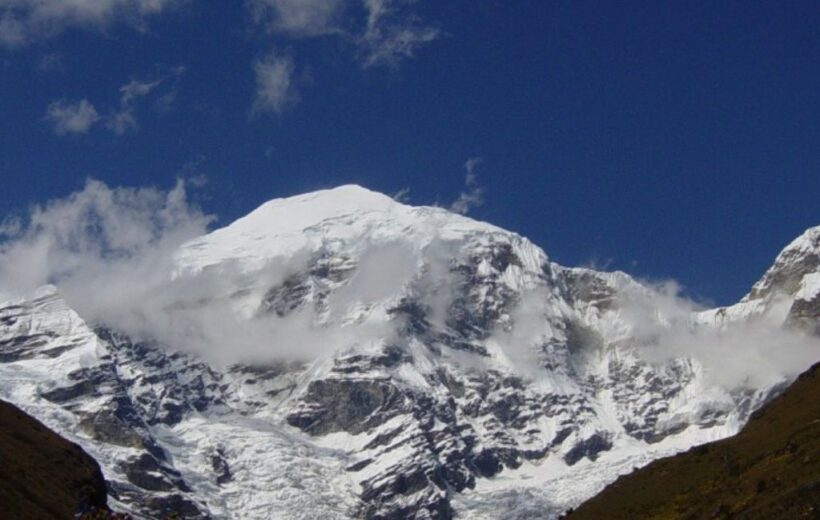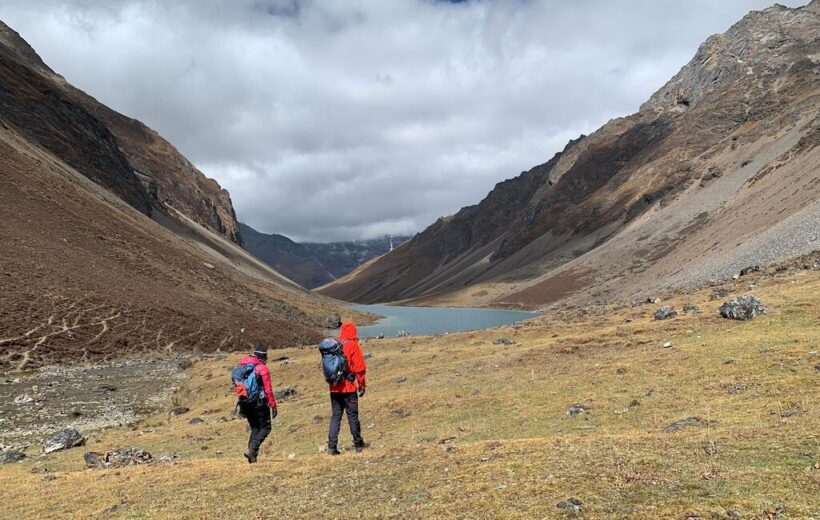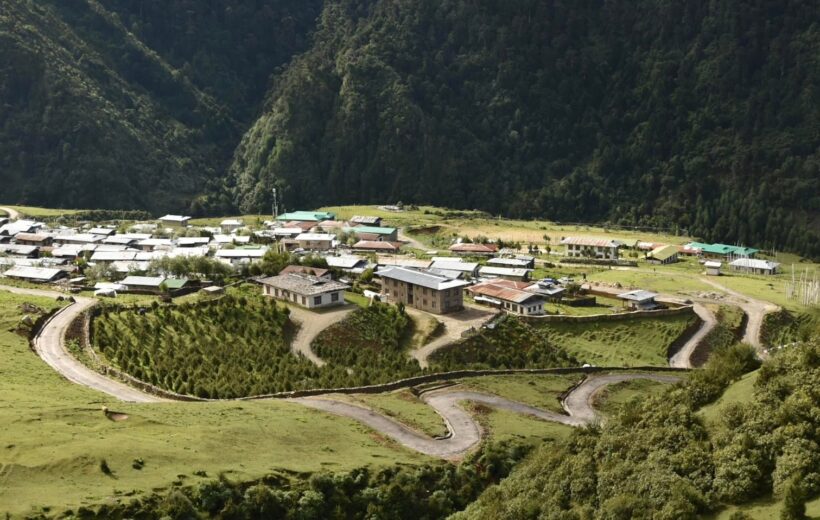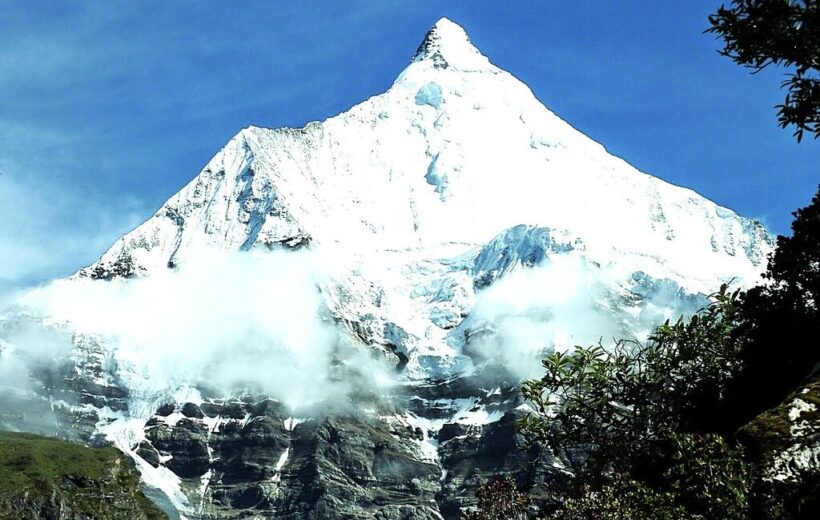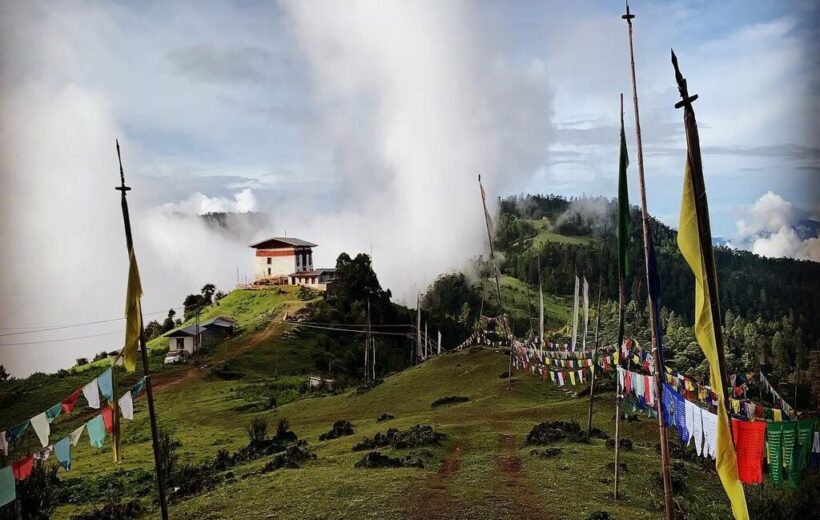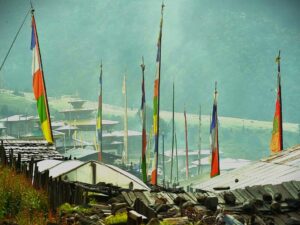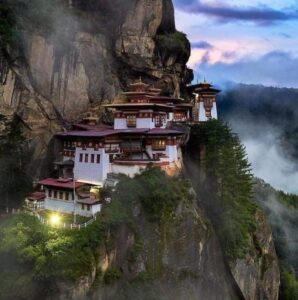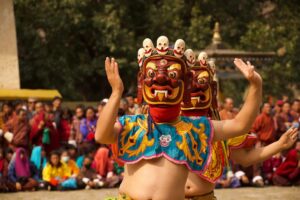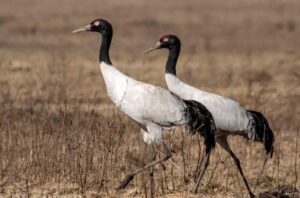Overview
The Nabji Trail is a perfect post-harvest or winter trekking route, open from October to March. This six-day, low-altitude trek (693m/2,274ft to 1,636m/5,367ft) is set in the ecologically rich Jigme Singye Wangchuck National Park in central Bhutan. The park is not only home to diverse wildlife but also several culturally vibrant agricultural villages.
The trail begins at Riotala (1,060m/3,478ft) and ends at Tongtongphey (1,061m/3,481ft), two small villages located along the Trongsa-Zhemgang Road, in the buffer zone on the eastern side of the Mangde Chhu River. Trekkers may encounter the endangered Golden Langur, a rare primate found only in Bhutan and Assam, as well as the Rufous-necked Hornbill. The trail is also a paradise for bird enthusiasts, with sightings of species such as serpent eagles, golden-throated barbets, and yellow-bellied flowerpeckers, alongside more common birds like mynas and blue-fronted redstarts. The region’s flora includes Chir Pine, bamboo, rhododendrons, and wild orchids.
Beyond its natural beauty, the trail is steeped in history. A highlight is the Nabji Temple, which houses a commemorative pillar marking the peace treaty brokered in the 8th century by Guru Rinpoche between King Nauche of India and King Sindu of Bhutan. Evidence of Guru Rinpoche’s presence can be found at various points along the trek.
The final two days of the trek pass through the homeland of the Monpa people, believed to be Bhutan's earliest settlers. Their traditional villages are scattered across slopes overlooking the Mangde Chhu River, in one of Bhutan’s earliest settlement regions. The Monpas practice a mix of animistic shamanism and Buddhism and are skilled in cane weaving and bamboo crafting, which they use to build homes and create baskets and household items. The term "Monpa" means "people of darkness," reflecting their historical isolation before the advent of Buddhism in Bhutan
The Nabji Trail plays a key role in supporting park management by raising awareness of environmental and cultural conservation through tourism programs. It also provides socio-economic benefits to local communities while minimizing the negative impacts of tourism. Specific measures have been implemented to ensure tourism supports livelihoods in the area and promotes awareness of natural, environmental, and cultural issues.
This trail has long been used by villagers for commuting between villages. To protect the environment, a waste management system requires tour groups to carry all non-degradable waste out of the park. Waste can be disposed of at an incinerator located at the Park Range Office in Tongtongfey, which serves both tour groups and the local community.
The trail is designed for local communities to manage and provide services independently. These services include community camping sites with basic facilities at Nimshong, Korphu, Kubdra, and Jangbi, or bucket showers and hot stone baths at Nabji. Meals, tea, and other services are also offered. Prices for these services are standardized to avoid misunderstandings between communities, tour operators, and visitors. Each village has a Tourism Management Committee (TMC) appointed by villagers, which oversees services, collects revenue, and manages funds through a Community Development Fund (CDF). Revenue is deposited into a CDF bank account for the community’s benefit.
Income opportunities are shared among villagers on a rotation basis. Community members earn by acting as porters, guides, or cooks, and by selling crafts, vegetables, and agricultural products. Cultural performances are another source of income. A portion of the earnings from these activities is deposited into the CDF, which is used for village development, educational support for children, and maintenance or expansion of tourism facilities. The fund also supports projects that benefit individuals not directly involved in tourism, such as children and the elderly.
Service Rates:
The standard rates for the basic service package and optional services will be shared soon. Revenues from specific services will go directly into the Community Development Fund (CDF). For other services, a percentage of the revenue will go into the CDF, while the rest stays with the local service provider.
Included/Excluded
- The Bhutan SDF
- All accommodations
- Meals and mineral water
- A licensed English-speaking guide
- A driver and vehicle
- Air fare
- A visa fee of US$40
- Alcohol
- Gifts/Souvenirs
- Travel insurance and personal bills
- Museums & Monument Fees
Tour Plan
Day 1:
Route: Trongsa (2,200m/7,333ft) to Nimshong Village (1,319m/4,367ft)
The first day begins with a short tour of Trongsa Dzong and Ta Dzong, overlooking the Mangde River. From there, a bus takes you toward Zhemgang, stopping at Riotola (1,060m/3,533ft), the starting point of the Nabji Trail. Keep an eye out for deer and macaques along the way and enjoy stunning views of the Mangde Valley.
The trek starts with a steep descent of 693m (2,310ft) to the Mangde River. After about an hour, you’ll reach Matling (804m/2,600ft), a great spot to rest. Continuing for another 30 minutes, you’ll find a chorten marking the entry to Nimshong village, followed by a steep two-hour climb.
Nimshong is a small village of around 58 households and 465 people. Villagers greet visitors with traditional songs and dances while dinner is prepared. The campsite (1,319m/4,397ft) is located next to the Nimshong Community School, above the village.
Day 2:
Total Distance: 13km; 4–6 hours
Route: Nimshong Campsite (1,319m/4,397ft) to Nabji Campsite (1,300m/3,827ft)
Start the day with a visit to the local temple, guided by a village guide. The trek takes you through a lush broadleaf forest teeming with wildlife, offering chances to spot the rare Golden Langur and Rufous-necked Hornbill. Although Nabji village is at a similar elevation as Nimshong, the trail weaves through dense forests, with frequent ascents and descents.
Nabji is a picturesque village with around 55 households and a population of about 400. It sits on a foothill above terraced rice fields. The village’s main attraction is the Nabji Temple, which holds a stone pillar symbolizing the peace treaty between the kings of Bumthang and Assam. You can also see rock remnants linked to a blacksmith, believed to be one of Pema Lingpa’s reincarnations.
Spend the night at the campsite, nestled among Nabji's scenic rice fields.
Day 3:
Total Distance: 9.5–13km; 4–5 hours
Route: Nabji Village (1,300m/3,827ft) to Korphu Lunch Spot (1,636m/5,453ft)
From the base camp in Nabji, take a scenic day hike to Korphu village, perched on a mountaintop at an altitude of 1,500m (5,000ft). This charming village has 76 households and a population of approximately 600. The uphill trail offers stunning views, and the panoramic scenery from Korphu is truly breathtaking.
While in Korphu, you can visit the local temple, which houses sacred relics of Pema Lingpa. A traditional lunch will be served in the village, giving you a taste of the local culture. In the afternoon, return to Nabji, completing the day’s hike.
Day 4:
Total Distance: 11–14 km; 5–7 hours
Route: Nabji/Korphu Campsite to Kubdra Campsite (1,636m/5,453ft)
Today's trek takes you from Nabji village, starting at the sacred tree, toward Kubdra village. The trail is captivating, leading through dense forests filled with towering trees, hanging climbers, orchids, and small bamboo groves. After about 5 to 6 hours of trekking, you’ll reach a resting spot at Zhelyung (1,565m/5,217ft), where benches are available. This is a perfect place to enjoy your lunch while admiring the view of a nearby waterfall.
Continuing on, the trail takes you deeper into the forest, eventually arriving at Kubdra after roughly six hours of hiking. Along the way, you may notice signs of wildlife such as tigers and leopards, though actual sightings are rare. Evidence like droppings and spoor can sometimes be seen.
Kubdra, home to only three households, is nestled in the heart of the forest and inhabited by a small group of Monpa people. Despite their modest settlement, the Monpas warmly welcome visitors to their campsite, making your stay memorable
Day 5:
Total Distance: 13–14.5 km; ~6 hours
Route: Kubdra Campsite (1,636m/5,453ft) to Jangbi Village (1,368m/4,560ft)
The trek continues from Kubdra to Jangbi village, with more traces of Guru Rinpoche along the way, including a footprint, dagger, and hat. You will briefly visit the small village of Phrumzur, which has a temple located at 1,400m. From the temple, enjoy a stunning view of the valley while having lunch.
The hike then proceeds through pristine forests with amazing views of the surrounding landscape. Upon reaching Jangbi, you’ll be welcomed with tea in an orchid garden. Here, you can learn more about the Monpa people and their Cane and Bamboo Project. The campsite is located near Jangbi village, offering a breathtaking view of the valley and the Mangde Chhu River.
Day 6:
Total Distance: 7–9.5 km; ~3–4 hours
Route: Jangbi Campsite (1,368m/4,560ft) to Tongtongfey (1,061m/3,537ft) to Trongsa
The day begins with a steep 950-meter descent to the Mangde Chhu bridge, followed by a final climb to Tongtongfey. From there, a bus will take you back to Trongsa, where you can enjoy a comfortable bed and a refreshing shower. If time allows, you can stop at the Kuenga Rabten Palace and the Nunnery on the way back. Overnight stay in Trongsa or your next destination.
Alternative Itineraries:
- Reverse the Itinerary: Start in Tongtongfey and finish in Riotala.
- Spend the Night in Korphu: Instead of going to Nabji on Day 2, you can hike up to Korphu and stay there overnight. On Day 3, hike down to Nabji and stay for one night before continuing to Kubdra on Day 4.
Tour Map
You may like
Frequently asked question
Itinerary is always flexible if you are travelling in a smaller group. You have a choice of eating in a different restaurant, however, the menu depends on the chef and usually it is a set menu but not necessarily the same menu every day.
It is in the tourism industry but it is not compulsory. It actually depends on the service rendered to you.
Yes, things that are not included in the tariff are all beverages, telecommunications, tips, laundry, massage and souvenir shopping.
Bhutan is well connected and every town has IDD services. Internet cafes are available almost everywhere. Cell phones can also be used but you need to get Bhutan prepaid SIM Card and recharge it. Recharge vouchers are available at every second shop in town.
You can exchange money in the banks as well as in the hotels were you are staying. Rates will be better in the banks plus US$ is acceptable in almost all of the shops in town.
It cannot be safer anywhere else in the world.
Bhutan is all season tourist destination for cultural tours. However the month of February, March, April, and September, October, November are considered the best time due to pleasant weather conditions. December and January are winter months and June, July and August, the rainy season. It is important to note that the climatic conditions during the winter months are not extreme. The average temperature would range from 10-17 degree Celsius during day time.
The money you have transferred will be with held by the Tourism Council of Bhutan till the day you depart. Travel Agents can only withdraw the money after your departure upon submitting your tour invoice. Therefore, your money is safe.
It is government rule that total tour payment must be remitted without which the government will not issue the visa.
Decide the number of days you want to spend in Bhutan according to your interest and budget.
Decide the date and the port of entry (You can fly into Bhutan from one of these cities; Bangkok, Katmandu, New Delhi, Calcutta and Dacca) into Bhutan.
Fill up the visa application form (You can download the visa application form here).
Remit the total tour payment (You can download the money transfer details here). It is government rule that total tour payment must be remitted without which the government will not issue the visa.
Once we have confirmed dates, port of entry, dully filled visa application form, and money received, we will process your visa.
Except for travelers from India, Bangladesh and Maldives, all visitors to Bhutan are required to obtain visa approval prior to their arrival, which will be processed by us.
Tourism is not restricted but the minimum daily tariff is set by the government. It is also necessary that all tourists must come through a registered tour operator to plan your itinerary and process your visa. Tourist cannot come on their own unless they are invited guest.
Druk Air operates daily flight (once daily) from Bangkok (Thailand) and four flights a week from New Delhi, Kathmandu and Calcutta (India) and two flights a week from Dacca (Bangladesh). There are different flight schedules for the summer and the winter seasons. For Druk Air schedules click on Flights Details or you can also visit Druk Air web site at www.drukair.com.bt . You can also enter Bhutan via Bagdogra Airport, Siliguri (West Bengal) in India. It has regular flights from New Delhi (twice daily).
Bhutan is connected to the outside world through Druk Air (Royal Bhutan Airlines), the national carrier which is the only airline operating flights in and out of the kingdom.

